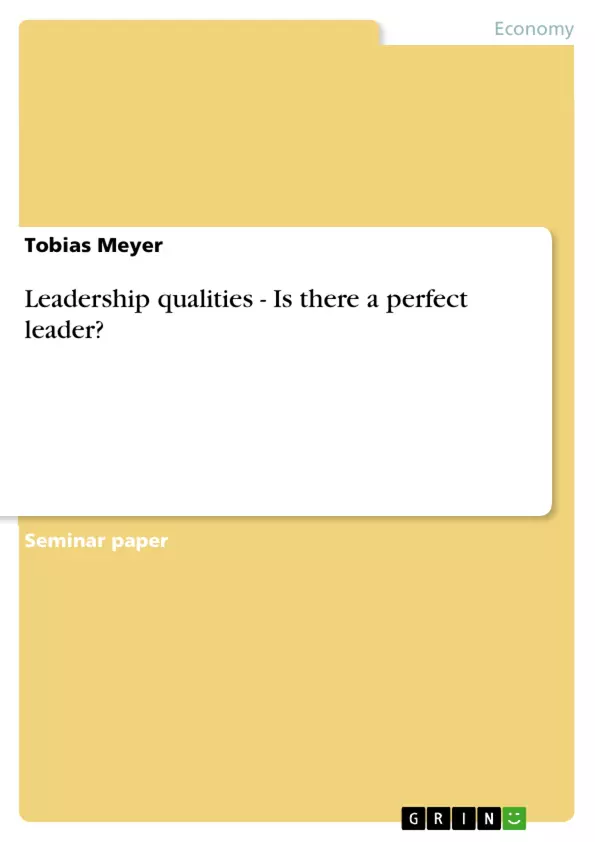The first thing most people think of when they hear leadership quality is
the leading of other people. But there is more to it than that.
“In companies (…) people work towards a specific goal. Companies
(…) are therefore (…) organizations. The activities, which are directed
towards coordinating and arranging the different (resources
and, added by authors) behavior patterns of the members of an organization
can be named as leading and management activities.”1
To be successful in the above-mentioned activities requires leadership
qualities.
Proceeding globalization leads to tougher competition on the markets.
Companies have to encounter this situation. To reach this goal the innovation
and knowledge potential of the organization has to be activated.
Therefore the significance of leadership increases.
The goal of the report is to give the reader an insight on what leadership
qualities are about, to bring together several existing approaches and to
structure leadership qualities. It will be analyzed whether it is possible to
find a set of leadership qualities, which constitutes an ideal leader.
At first leadership will be described in a historical context. Then three
theoretical concepts will be explained and brought in line with a synthesis.
Those are the manager types by Maccoby, The continuum of leadership
behavior of Tannenbaum and Schmidt and the fields of leadership
qualities by Kets de Vries with amendments of the authors. To find
out whether an ideal leader exists the theory will be applied on two
Chief Executive Officers. The focus is on leadership in economic environments but leadership is
also present in politics which will be taken into account as well.
[...]
Inhaltsverzeichnis (Table of Contents)
- Introduction
- History
- Historical development of leadership
- Parallels with Maslow's Hierarchy of Needs
- Theoretical Concepts
- Manager types
- Continuum of leadership behavior
- Fields of leadership qualities
- Visions
- Sense Management
- Social Competence
- Analysis Capabilities
- Authenticity
- Leading Others
- Expert Knowledge
- Power to resist/Staying power
- Translation into action
- Synthesis
- The Expert
- The Helper
- The Defender
- The Innovator/The Self-Developer
- Practical orientation
- Portraits: Frank Appel and Thomas Enders
- Classification of Enders and Appel into the fields
- Specification of the attributes for Appel and Enders
- Comparison of Appel and Enders
- Classification into Syntheses types
- Critical Analysis
- Conclusion
Zielsetzung und Themenschwerpunkte (Objectives and Key Themes)
This paper aims to explore the concept of leadership qualities and investigate if a "perfect leader" exists. It examines historical development, theoretical concepts, and practical examples to understand the attributes and challenges of effective leadership.- Historical evolution of leadership models
- Key attributes and qualities of successful leaders
- Continuum of leadership behavior and styles
- Case studies of real-world leaders to illustrate different approaches
- Critical analysis and reflection on the concept of a "perfect leader"
Zusammenfassung der Kapitel (Chapter Summaries)
- Introduction: This chapter introduces the topic of leadership qualities and sets the stage for the investigation into whether there is a perfect leader.
- History: This chapter delves into the historical development of leadership, exploring different models and theories throughout history. It also draws parallels between leadership theories and Maslow's Hierarchy of Needs.
- Theoretical Concepts: This chapter examines various theoretical concepts related to leadership, including different manager types, the continuum of leadership behavior, and specific fields of leadership qualities such as vision, sense management, and social competence.
- Synthesis: This chapter synthesizes the theoretical concepts into four distinct leadership types: the Expert, the Helper, the Defender, and the Innovator/Self-Developer.
- Practical orientation: This chapter provides practical examples of leadership by analyzing the leadership styles of Frank Appel and Thomas Enders. It classifies them according to the fields of leadership qualities and the synthesized types.
- Critical Analysis: This chapter offers a critical analysis of the findings, examining the strengths and weaknesses of different leadership styles and perspectives.
Schlüsselwörter (Keywords)
This work explores the essential aspects of leadership qualities, analyzing key themes like historical development, theoretical concepts, manager types, leadership behavior, vision, social competence, and critical analysis. The text examines various leadership approaches through case studies, highlighting the attributes of successful leaders and exploring the concept of a "perfect leader."- Quote paper
- Tobias Meyer (Author), 2008, Leadership qualities - Is there a perfect leader?, Munich, GRIN Verlag, https://www.grin.com/document/115579



